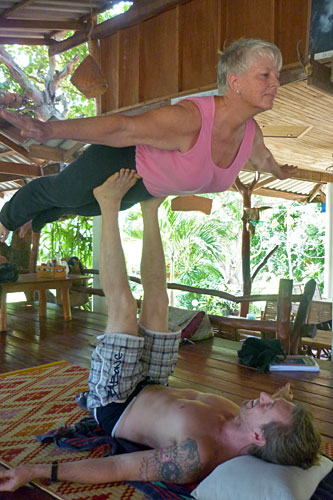Typically the second pose taught in Acro Yoga, front bird (AKA Front Plank, Birdie, Superman, etc.) is the beginnings of acrobatic flying. 
Base
As the flier steps into place, position your feet with parallel feet centering the arches of your feet on their anterior iliac crest (front hip bones). Offer your hands to the flier with fingers turned out and thumbs wide. Initially your legs are bent deeply and your arms are straight. Smoothly draw the flier’s weight into you by bending your arms drawing them more over you and as weight shifts into you straighten your arms and legs. Ensure that both you and the flier have strong straight arms and that your arms make one straight vertical line, not bowed at the intersection of your hands. Here the base can control the angle of the flier’s body by extending and flexing the feet (often referred to as “more toe” and “less toe”). By giving more toe, you may be able to let go of the hands and balance the flier purely on your feet!
Flier
There are several ways to enter into front bird as the flier: holding hands, holding shins, or going in hands free. First walk very close to your base such that your toes almost touch the base’s buttocks. Ensure their feet are centered on your hip bones and parallel. Hold hands like you are about to do down dog (fingers forward), lean forward and allow your base to take your weight into their legs. As that happens, stay strong in your core and stay straight (do not fold or pike at the hips – if you do, the base’s toes will hurt your belly). Keep your straight strong arms the whole time and allow the base to balance you with their feet. You can ask for more toes or less toes (as described above). Look forward and open your heart/chest. Think salabasana, locust pose, with your torso and legs reaching long. If you chose to let go of the hands, reach your arms by your sides, palms down. Do not reach your arms forward.
Spotter
Standing at the side with hands around (but not touching) the fliers hips, here the spotter continues to learn the art of spotting. The spotter can also use the sandwich approach with one hand above and one hand below the flier’s abdominal area. Touching only when needed to prevent falls or injury, staying present and aware with what the base and flier are doing, and staying out of the way as they move is the art of being a great spotter! If they do tip, either 1) help them back to centered balance or 2) help the flier safely return to the earth, preferably on their feet. =) Another job for the spotter is to help guide the base and flier. If the base’s legs are not straight up and down (vertical) tell them which direction to move their feet to straighten them out. Remind the flier to keep their gaze You can also act as a go-between for communicating if flier and base can’t hear each other.